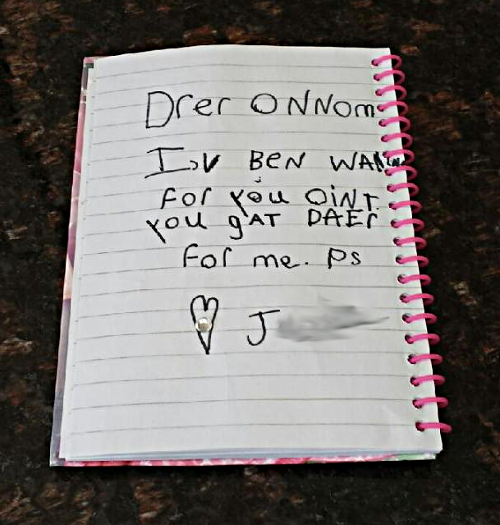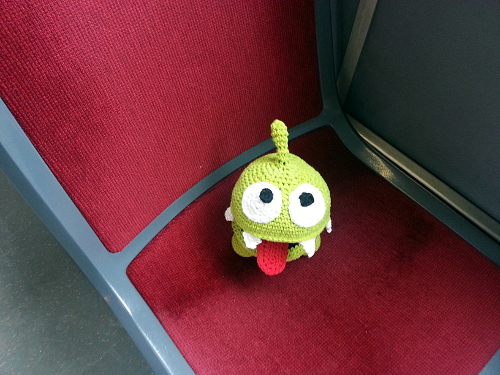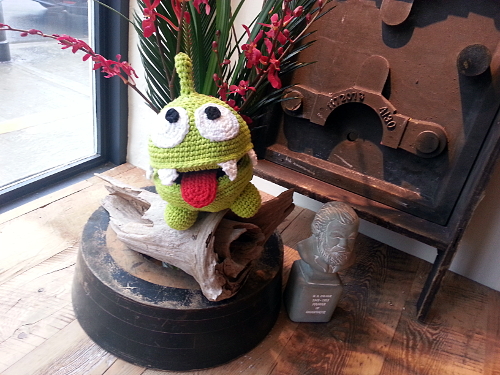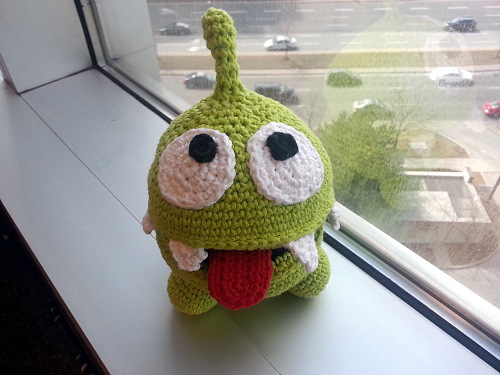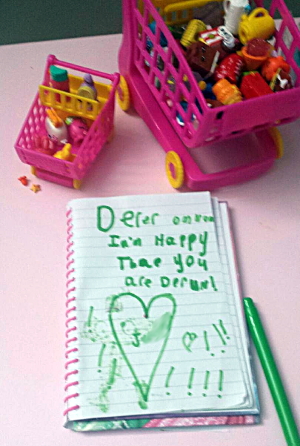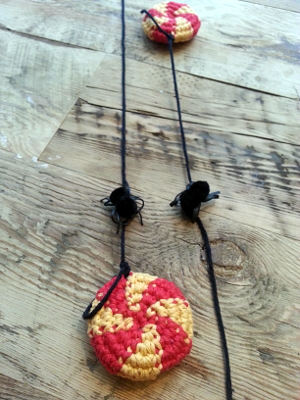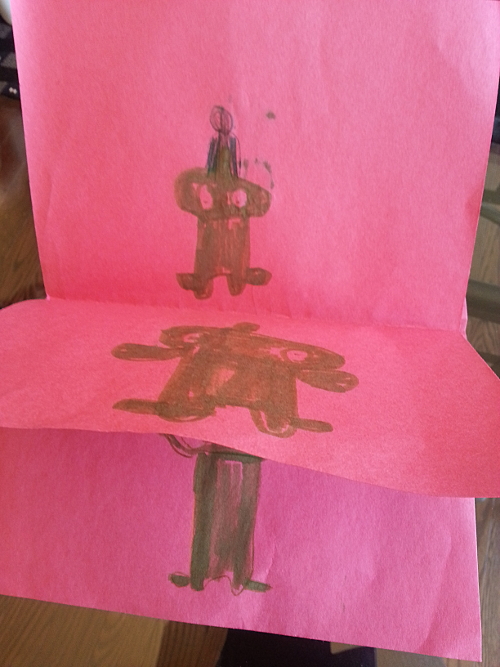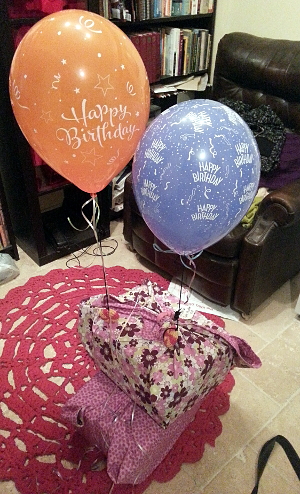I tried making a swirl jacket last autumn, and summed up my problems with the directions/sizing and decision to rip it all out in a blog post. This past week I've been off whilst recovering from surgery, so I decided to finish unravelling the work, make a new gauge swatch (more on that below), and sit down with the pattern book and a spreadsheet.
What I learned has put me off making any sort of swirl from the yarn I had set aside for it. The reasons why mostly have to do with what I found out from my spreadsheet, but also some "helper" information I found on the author's web site. My main take-away is that it would be very difficult to get predictable results if one went by the book alone. I would go so far as to say that making any adjustments for fit at all would require a virtual redesign without the information on the web site.
I didn't like the fabric hand of the original swirl jacket, so decided to go up to 5.5mm needles to get less springy fabric. The gauge swatch in the photo above is 50 stitches wide by 50 rows high. As you can see, the welted fabric (used on every pattern in the book) makes a horizontal rib. Horizontal ribs are pretty much the same width as a similar piece of stocking stitch, but their length/row gauge is going to change drastically depending on whether the fabric is unstretched, slightly stretched, or as stretched as it can be without distorting the stitches. I couldn't find anywhere in the book which actually says how much you're supposed to stretch the fabric to measure row gauge (there is an explainer on the web site since "knitters" were having trouble with it). In the book there is a lot of detail about making a larger-than-normal swatch, washing and blocking it, etc. etc., but never how to actually measure the thing. That seems like a weird omission for a ribbed fabric. Usually an author will at least put in the standard "slightly stretched" directive.
I took one stitch measurement and three row measurements based on different amounts of stretch applied (without reducing stitch width), and got for 10cm/4":
- 18 stitches
- 25 rows when pulled out to "maximum" (matches stocking stitch row height without distorting the stitch width)
- 30 rows slightly pulled out
- 45 rows fully scrunched (not pulled out at all)
Large, horizontally-draping parts of the jacket, like the lower back, will stretch from their own weight. Vertically-oriented parts, like the collar lapels, will hardly stretch at all. A big fitting issue I had with the original jacket I made was that while the back and shoulders fit well, the fronts could not be closed except by stretching the fronts to their maxium — not very flattering! It seems telling that most sizing photos show the jackets with the fronts open. If I'm going to make a large, A-line jacket, I want to know it can close. I know plus-sized people are supposed to resign themselves to cold stomachs and chests to look flattering, but I refuse when it comes to custom-made clothing. Especially clothing that claims to flatter a large variety of body types.
Okay, I had my gauge swatch — now what? I went through the pattern book, noting all of the patterns which had a similar gauge, their shape category, and the few measurements provided (just for my yoke size, size 3). The list included:
- Winter Waves (Centred Circle)
- Tangerine Rose (Centred Circle)
- Silken Dreams (Off-centre Circle)
- Strata Sphere (Off-centre Circle)
- Shades of Grey (Off-centre Circle)
- Plum Perfect (Off-centre Circle)
- Wild Thyme (Off-centre Oval)
- Coat of Many Colours (Off-centre Oval)
- Silhouette in the Sun (Off-centre Oval)
Note that none of the Centred Oval patterns were even close to the gauge swatch, because they were all made with much thinner yarns.
Now that I had the required gauge and measurements in a spreadsheet, I started calculating the other measurements I wanted to consider, using the following assumptions/calculations:
- the cross-back measurement: width of the non-collar stitches right before sleeve/upper back shaping began
- armhole depth: the number of rows from the first sleeve increase to the welt at the top of the sleeve
- body circumference: The cross-back measurement plus 2x the row depth of the fronts up to the sleeve/upper back shaping. Because the fronts/lapels hang vertically and therefore are stretched by their own weight less, I did this twice — once assuming slight stretch, and once assuming no stretch.
If my numbers are right, the swirls all seem to top out with an effective body circumference of 44 inches. That explains why the vast majority of photos of plus-sized people wearing them on Ravelry have them open, with the sides hanging well away from centre front.
For my own measurements, that means if the fabric has a loose enough hand, I'll just be able to find a swirl I can close, so long as I stick to shapes with more generous fronts. Therefore I focused on the Off-centre Ovals, since they have wider fronts.
Problem is, the book also says they have "more fitted torsos" and "slim, tapered sleeves". Okay, sleeves are easy to alter, but I wasn't sure what the "torso" part meant. The upper back, which is the only part that has any shaping? My spreadsheet was showing the smallest armhole depth to be a still-generous 14.1", so I really wasn't sure what this meant besides "not dolman sleeves".
And then I read this note on the web site about how gauge and fabric hand work together in a swirl. The 100% wool yarn I had set aside for the project was only useful for two jackets out of the entire book. Sure, I'd noticed there was a lot of cashmere and silk listed in the book, but I'd just shrugged it off — lots of books use luxury fibres in their samples. They photograph beautifully, and suppliers will donate them for the promotion the book will provide. I've made lots of natural-fibre sweaters which cost less than even one skein of a luxury-fibre yarn, though. I can almost justify a silk blend to myself, just because it's so hard-wearing, but cashmere? Nah. There were some mohair and alpaca blends listed as well, which can be more reasonable in cost, but still. This jacket was supposed to be a stash-busting project, not an excuse to get sticker shock over exotic yarn.
This time the silk and cashmere matter, because they're less stretchy than wool. Despite the welted fabric, the idea is to create a fabric that will stretch out and stay that way. Lesson learned: the welts are to:
- create a reversible fabric so things like lapel fold depth can remain vague
- create extra stretch in certain parts of the jacket (sleeve cross-measurements, those pesky fronts) to justify the hand-waving about "flattering a wide variety of body sizes".
Of the two patterns which were designed with 100% wool in mind, only one was an off-centre oval (Coat of Many Colours), and its gauge was two stitches per 10cm/4" smaller than my swatch: 20 stitches instead of my 18.
Okay, I'd already made a spreadsheet 19 columns wide; may as well see if I could follow a smaller size's directions and get the size I wanted. It's a common adjustment method, and one I've used many times before.
I entered the stitch counts for the longest sides of the body into my spreadsheet, then the goal measurement in inches I needed below that. Then I calculated out how many inches I'd get at 18 stitches to the inch, with the goal of seeing if any numbers in the smaller sizes matched what I needed in size 3.
What I found was a surprise: the size 3 numbers already matched. I figured I must have made a mistake, so I ran another row of the same calculations, using the pattern 20 stitches to 10cm/4". This is what I got.
(All measurements are in inches since that was all that was what was given on the book schematic):


























